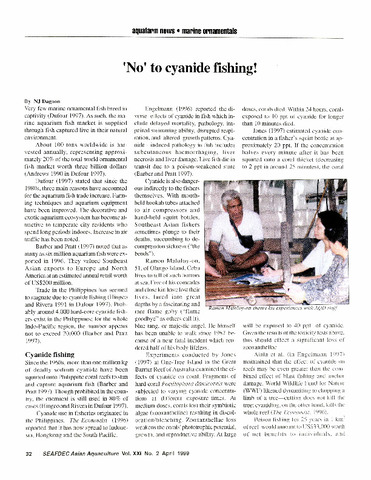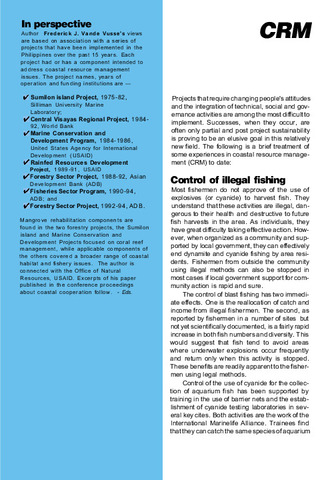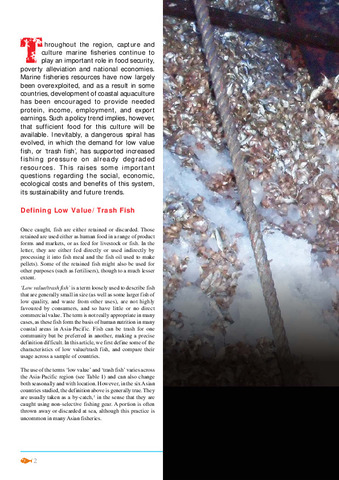| dc.contributor.author | de la Peña, Leobert D. | |
| dc.contributor.author | Suarnaba, Vonnie S. | |
| dc.contributor.author | Capulos, Geimbo C. | |
| dc.contributor.author | Santos, Mary Nia M. | |
| dc.coverage.spatial | Panay Gulf | en |
| dc.coverage.spatial | Iloilo | en |
| dc.coverage.spatial | Tigbauan | en |
| dc.date.accessioned | 2014-05-30T08:37:08Z | |
| dc.date.available | 2014-05-30T08:37:08Z | |
| dc.date.issued | 2011 | |
| dc.identifier.citation | de la Peña, L. D., Suarnaba, V. S., Capulos, G. C., & Santos, M. N. M. (2011). Prevalence of viral nervous necrosis (VNN) virus in wild-caught and trash fish in the Philippines. Bulletin of the European Association of Fish Pathologists, 31(4), 129-138. | en |
| dc.identifier.issn | 0108-0288 | |
| dc.identifier.uri | http://hdl.handle.net/10862/2114 | |
| dc.description.abstract | Viral nervous necrosis (VNN) caused by piscine nodavirus is a devastating disease affecting mainly marine finfish. In the Philippines, VNN was first reported in hatchery-reared grouper (Epinephelus coioides) broodstock in 2001. These broodstock are usually fed with trash fish. It is therefore suspected that contaminated trash fish may be the source of VNN transmission to the broodstock. To confirm the source of contamination, periodic monitoring of the VNN prevalence using RT-PCR was done on different species of trash fish available in the Iloilo Fishing Port Complex and on the wild-caught fish in Panay Gulf. Results showed that most of the trash fish and wild-caught fish were sub-clinically infected or carriers of VNN, and that the virus might have already been established in the environment where they were living. These findings provide strong evidence that trash fish could be the main source of viral contamination in broodstock since they are identified as the only major input in the culture systems. To prevent the transmission of VNN to broodstock through contaminated trash fish, a shift to a broodstock pelleted feed is highly recommended. | en |
| dc.description.sponsorship | The study was funded by the Government of Japan Trust Fund (GOJ-TF) and SEAFDEC/AQD under the study code FH-14-F2004T/8001-T-FDFH1104 with Contribution Number 2011-01. Thanks are due to Drs Y. Inui, K. Nagasawa, K. Okuzawa, H. Ogata and T. Azuma, fish disease experts/trust fund co-managers for their guidance and to M. Paner, M. Peniero, D. Catedral and R. Traviña for their technical assistance. | en |
| dc.language.iso | en | en |
| dc.publisher | European Association of Fish Pathologists | en |
| dc.rights.uri | http://creativecommons.org/licenses/by/2.5/scotland/ | |
| dc.subject | Epinephelus coioides | en |
| dc.title | Prevalence of viral nervous necrosis (VNN) virus in wild-caught and trash fish in the Philippines | en |
| dc.citation.volume | 31 | |
| dc.citation.issue | 4 | |
| dc.citation.spage | 129 | |
| dc.citation.epage | 138 | |
| dc.citation.journalTitle | Bulletin of the European Association of Fish Pathologists | en |
| dc.subject.asfa | marine fish | en |
| dc.subject.asfa | trash fish | en |
| dc.subject.asfa | fish diseases | en |
| dc.subject.asfa | viroses | en |
| dc.subject.asfa | viruses | en |
| dc.subject.asfa | PCR | en |
| dc.subject.asfa | disease recognition | en |
| dc.subject.asfa | breeding stock | en |
| dc.subject.scientificName | Epinephelus coioides | en |




